Organisational Dynamics and Behaviour: Theories and Models Report
VerifiedAdded on 2023/06/10
|8
|2126
|160
Report
AI Summary
This report provides an in-depth analysis of organisational behaviour, focusing on various theories and models to understand and improve workplace dynamics. It begins by introducing organisational behaviour and its importance in shaping organisational culture and employee performance. The report then delves into specific theories, including the Big Five personality traits model, McClelland's Human Motivational Theory, Tuckman's Behavioural Theory (forming, storming, norming, performing, adjourning), and the Rational Decision Making theory (bounded rationality). Each theory is examined in detail, with practical examples and experiences gained. The report highlights how these theories can be applied to understand individual behaviour, motivation, team development, and decision-making processes within an organisation. The report concludes by emphasizing the significance of organisational behaviour for maintaining smooth working conditions and achieving high levels of employee performance. References to relevant books and journals are also included.
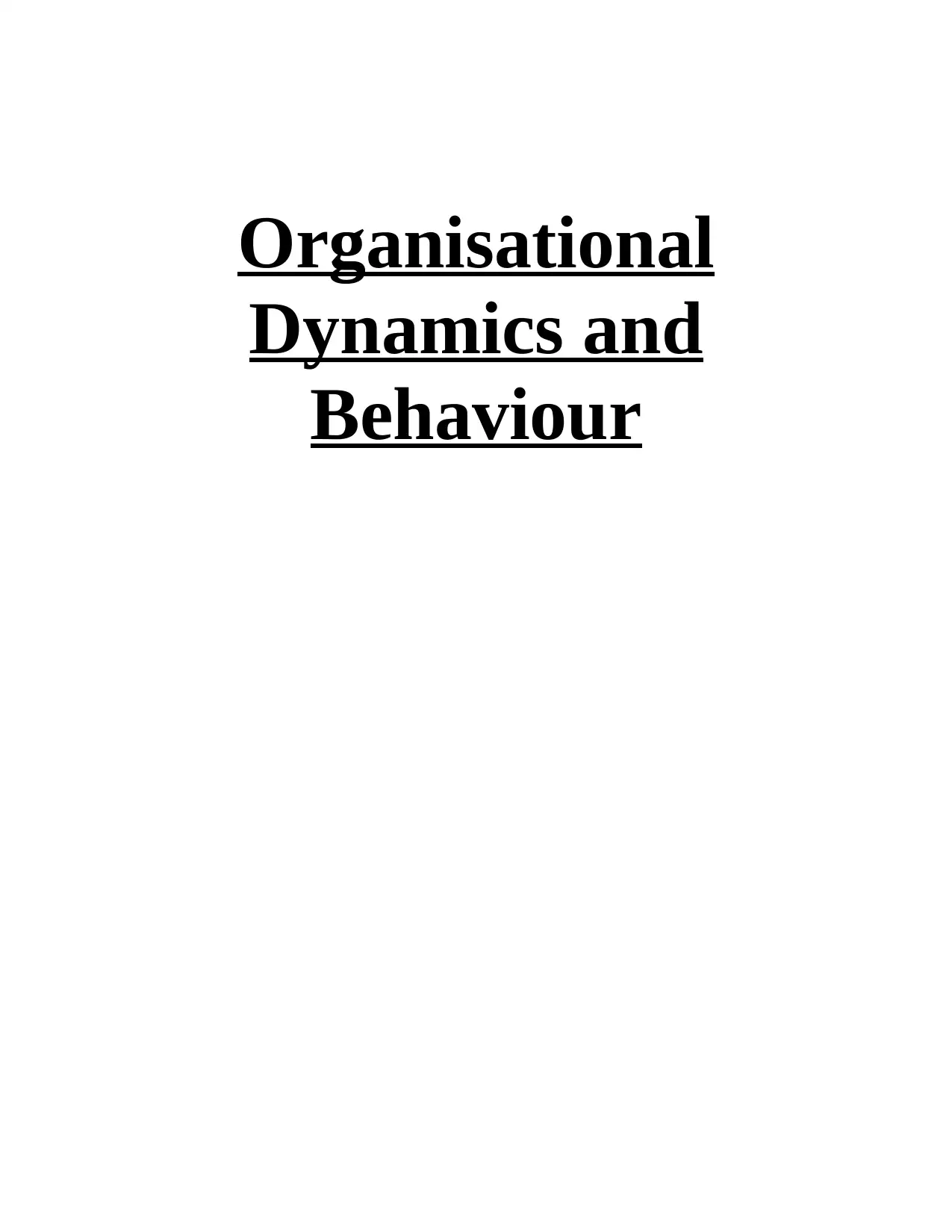
Organisational
Dynamics and
Behaviour
Dynamics and
Behaviour
Paraphrase This Document
Need a fresh take? Get an instant paraphrase of this document with our AI Paraphraser
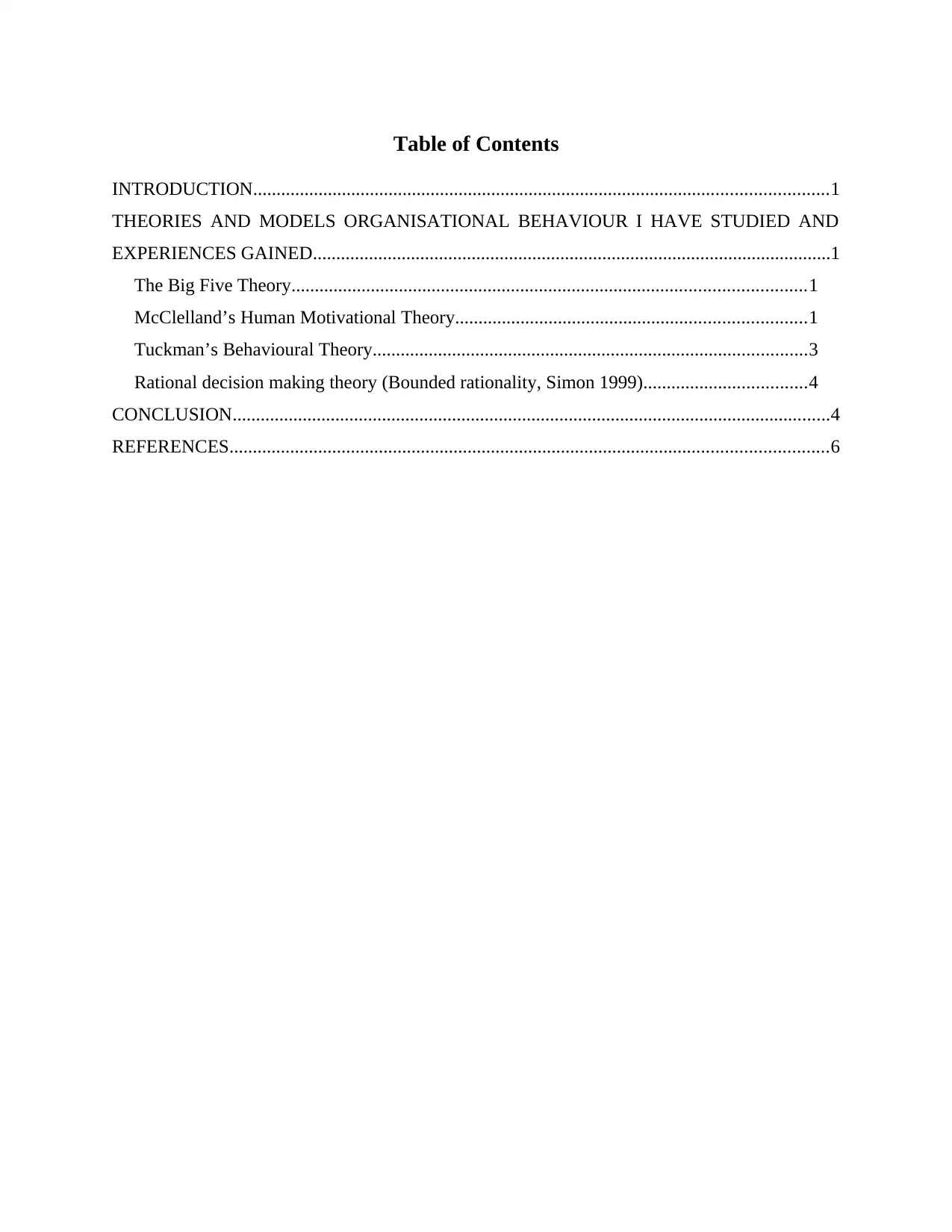
Table of Contents
INTRODUCTION...........................................................................................................................1
THEORIES AND MODELS ORGANISATIONAL BEHAVIOUR I HAVE STUDIED AND
EXPERIENCES GAINED...............................................................................................................1
The Big Five Theory..............................................................................................................1
McClelland’s Human Motivational Theory...........................................................................1
Tuckman’s Behavioural Theory.............................................................................................3
Rational decision making theory (Bounded rationality, Simon 1999)...................................4
CONCLUSION................................................................................................................................4
REFERENCES................................................................................................................................6
INTRODUCTION...........................................................................................................................1
THEORIES AND MODELS ORGANISATIONAL BEHAVIOUR I HAVE STUDIED AND
EXPERIENCES GAINED...............................................................................................................1
The Big Five Theory..............................................................................................................1
McClelland’s Human Motivational Theory...........................................................................1
Tuckman’s Behavioural Theory.............................................................................................3
Rational decision making theory (Bounded rationality, Simon 1999)...................................4
CONCLUSION................................................................................................................................4
REFERENCES................................................................................................................................6
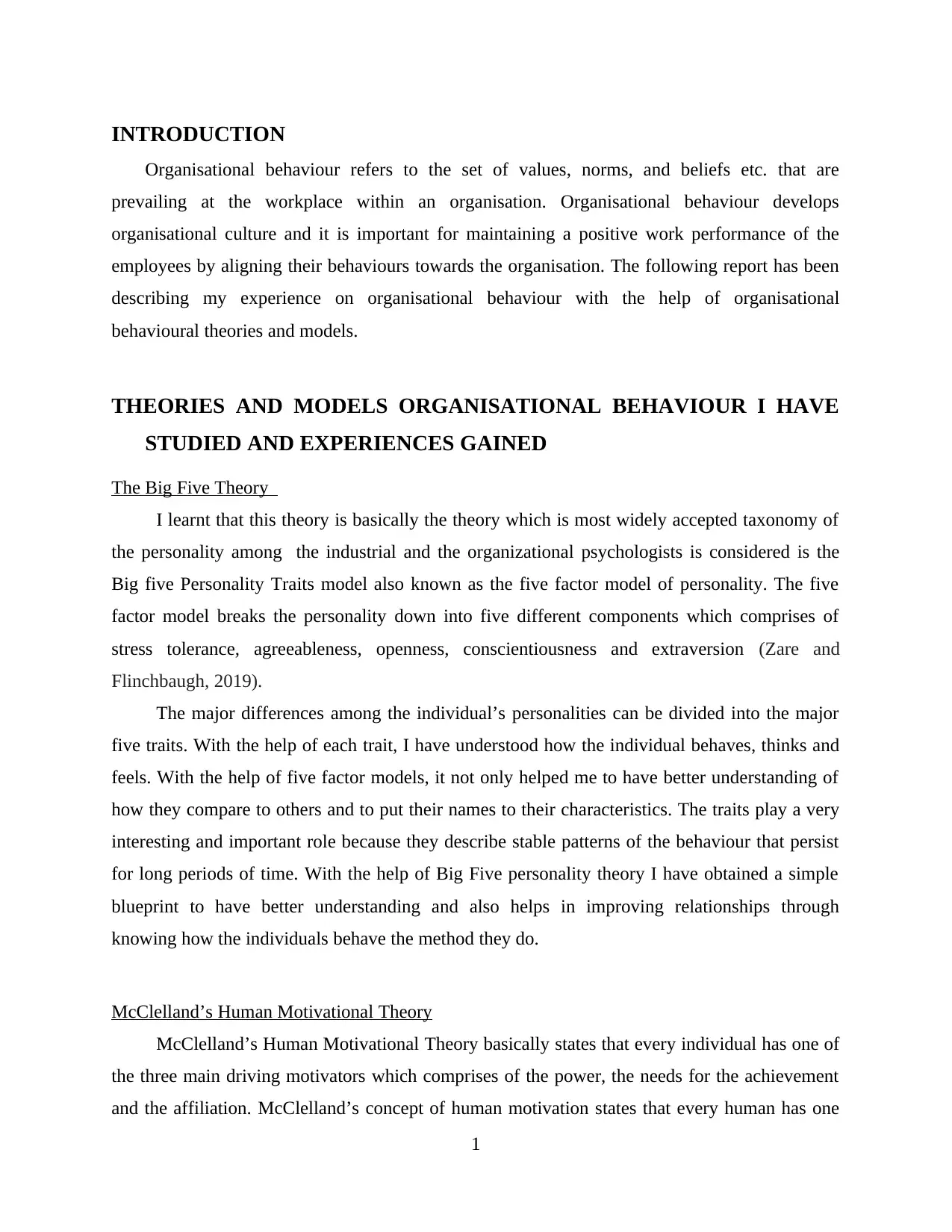
INTRODUCTION
Organisational behaviour refers to the set of values, norms, and beliefs etc. that are
prevailing at the workplace within an organisation. Organisational behaviour develops
organisational culture and it is important for maintaining a positive work performance of the
employees by aligning their behaviours towards the organisation. The following report has been
describing my experience on organisational behaviour with the help of organisational
behavioural theories and models.
THEORIES AND MODELS ORGANISATIONAL BEHAVIOUR I HAVE
STUDIED AND EXPERIENCES GAINED
The Big Five Theory
I learnt that this theory is basically the theory which is most widely accepted taxonomy of
the personality among the industrial and the organizational psychologists is considered is the
Big five Personality Traits model also known as the five factor model of personality. The five
factor model breaks the personality down into five different components which comprises of
stress tolerance, agreeableness, openness, conscientiousness and extraversion (Zare and
Flinchbaugh, 2019).
The major differences among the individual’s personalities can be divided into the major
five traits. With the help of each trait, I have understood how the individual behaves, thinks and
feels. With the help of five factor models, it not only helped me to have better understanding of
how they compare to others and to put their names to their characteristics. The traits play a very
interesting and important role because they describe stable patterns of the behaviour that persist
for long periods of time. With the help of Big Five personality theory I have obtained a simple
blueprint to have better understanding and also helps in improving relationships through
knowing how the individuals behave the method they do.
McClelland’s Human Motivational Theory
McClelland’s Human Motivational Theory basically states that every individual has one of
the three main driving motivators which comprises of the power, the needs for the achievement
and the affiliation. McClelland’s concept of human motivation states that every human has one
1
Organisational behaviour refers to the set of values, norms, and beliefs etc. that are
prevailing at the workplace within an organisation. Organisational behaviour develops
organisational culture and it is important for maintaining a positive work performance of the
employees by aligning their behaviours towards the organisation. The following report has been
describing my experience on organisational behaviour with the help of organisational
behavioural theories and models.
THEORIES AND MODELS ORGANISATIONAL BEHAVIOUR I HAVE
STUDIED AND EXPERIENCES GAINED
The Big Five Theory
I learnt that this theory is basically the theory which is most widely accepted taxonomy of
the personality among the industrial and the organizational psychologists is considered is the
Big five Personality Traits model also known as the five factor model of personality. The five
factor model breaks the personality down into five different components which comprises of
stress tolerance, agreeableness, openness, conscientiousness and extraversion (Zare and
Flinchbaugh, 2019).
The major differences among the individual’s personalities can be divided into the major
five traits. With the help of each trait, I have understood how the individual behaves, thinks and
feels. With the help of five factor models, it not only helped me to have better understanding of
how they compare to others and to put their names to their characteristics. The traits play a very
interesting and important role because they describe stable patterns of the behaviour that persist
for long periods of time. With the help of Big Five personality theory I have obtained a simple
blueprint to have better understanding and also helps in improving relationships through
knowing how the individuals behave the method they do.
McClelland’s Human Motivational Theory
McClelland’s Human Motivational Theory basically states that every individual has one of
the three main driving motivators which comprises of the power, the needs for the achievement
and the affiliation. McClelland’s concept of human motivation states that every human has one
1
⊘ This is a preview!⊘
Do you want full access?
Subscribe today to unlock all pages.

Trusted by 1+ million students worldwide
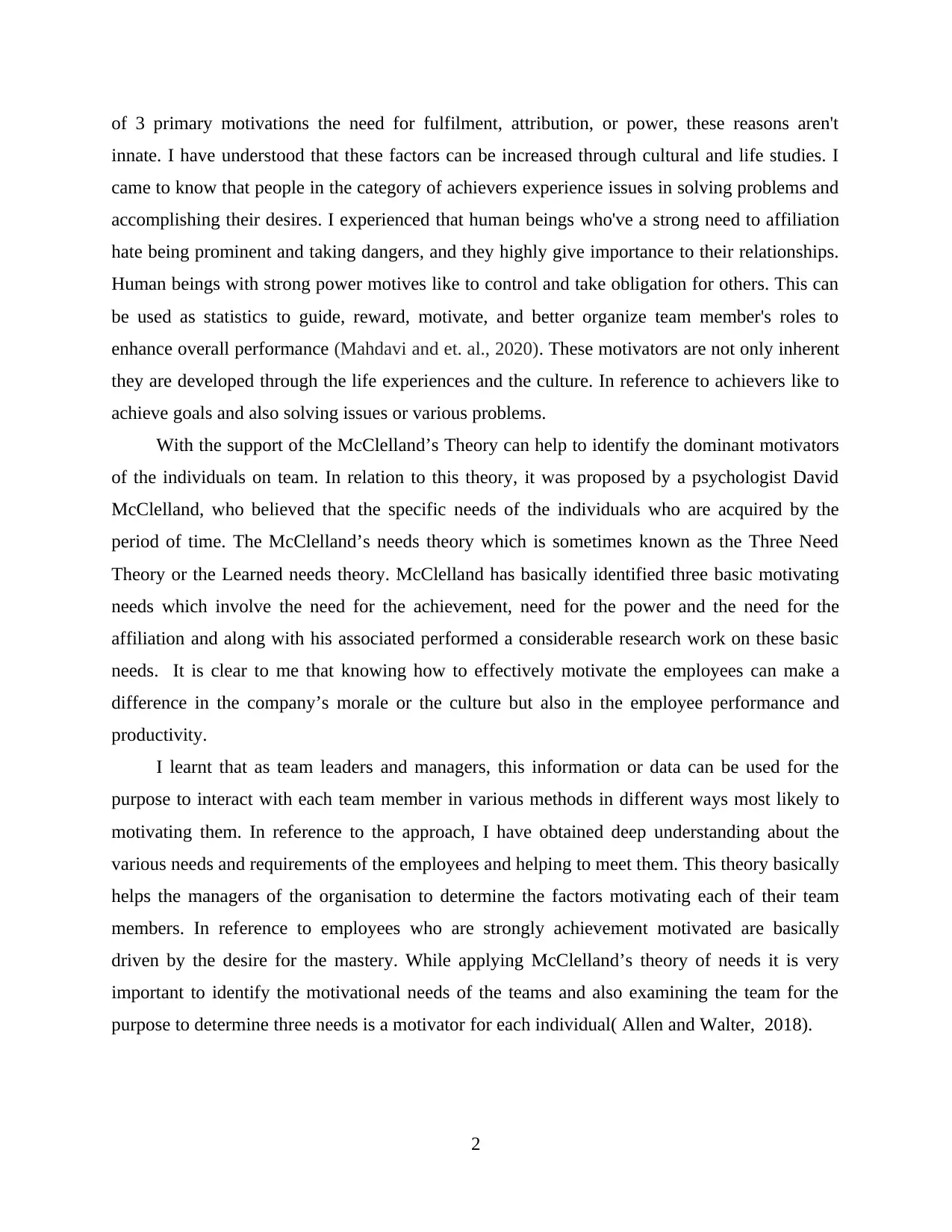
of 3 primary motivations the need for fulfilment, attribution, or power, these reasons aren't
innate. I have understood that these factors can be increased through cultural and life studies. I
came to know that people in the category of achievers experience issues in solving problems and
accomplishing their desires. I experienced that human beings who've a strong need to affiliation
hate being prominent and taking dangers, and they highly give importance to their relationships.
Human beings with strong power motives like to control and take obligation for others. This can
be used as statistics to guide, reward, motivate, and better organize team member's roles to
enhance overall performance (Mahdavi and et. al., 2020). These motivators are not only inherent
they are developed through the life experiences and the culture. In reference to achievers like to
achieve goals and also solving issues or various problems.
With the support of the McClelland’s Theory can help to identify the dominant motivators
of the individuals on team. In relation to this theory, it was proposed by a psychologist David
McClelland, who believed that the specific needs of the individuals who are acquired by the
period of time. The McClelland’s needs theory which is sometimes known as the Three Need
Theory or the Learned needs theory. McClelland has basically identified three basic motivating
needs which involve the need for the achievement, need for the power and the need for the
affiliation and along with his associated performed a considerable research work on these basic
needs. It is clear to me that knowing how to effectively motivate the employees can make a
difference in the company’s morale or the culture but also in the employee performance and
productivity.
I learnt that as team leaders and managers, this information or data can be used for the
purpose to interact with each team member in various methods in different ways most likely to
motivating them. In reference to the approach, I have obtained deep understanding about the
various needs and requirements of the employees and helping to meet them. This theory basically
helps the managers of the organisation to determine the factors motivating each of their team
members. In reference to employees who are strongly achievement motivated are basically
driven by the desire for the mastery. While applying McClelland’s theory of needs it is very
important to identify the motivational needs of the teams and also examining the team for the
purpose to determine three needs is a motivator for each individual( Allen and Walter, 2018).
2
innate. I have understood that these factors can be increased through cultural and life studies. I
came to know that people in the category of achievers experience issues in solving problems and
accomplishing their desires. I experienced that human beings who've a strong need to affiliation
hate being prominent and taking dangers, and they highly give importance to their relationships.
Human beings with strong power motives like to control and take obligation for others. This can
be used as statistics to guide, reward, motivate, and better organize team member's roles to
enhance overall performance (Mahdavi and et. al., 2020). These motivators are not only inherent
they are developed through the life experiences and the culture. In reference to achievers like to
achieve goals and also solving issues or various problems.
With the support of the McClelland’s Theory can help to identify the dominant motivators
of the individuals on team. In relation to this theory, it was proposed by a psychologist David
McClelland, who believed that the specific needs of the individuals who are acquired by the
period of time. The McClelland’s needs theory which is sometimes known as the Three Need
Theory or the Learned needs theory. McClelland has basically identified three basic motivating
needs which involve the need for the achievement, need for the power and the need for the
affiliation and along with his associated performed a considerable research work on these basic
needs. It is clear to me that knowing how to effectively motivate the employees can make a
difference in the company’s morale or the culture but also in the employee performance and
productivity.
I learnt that as team leaders and managers, this information or data can be used for the
purpose to interact with each team member in various methods in different ways most likely to
motivating them. In reference to the approach, I have obtained deep understanding about the
various needs and requirements of the employees and helping to meet them. This theory basically
helps the managers of the organisation to determine the factors motivating each of their team
members. In reference to employees who are strongly achievement motivated are basically
driven by the desire for the mastery. While applying McClelland’s theory of needs it is very
important to identify the motivational needs of the teams and also examining the team for the
purpose to determine three needs is a motivator for each individual( Allen and Walter, 2018).
2
Paraphrase This Document
Need a fresh take? Get an instant paraphrase of this document with our AI Paraphraser
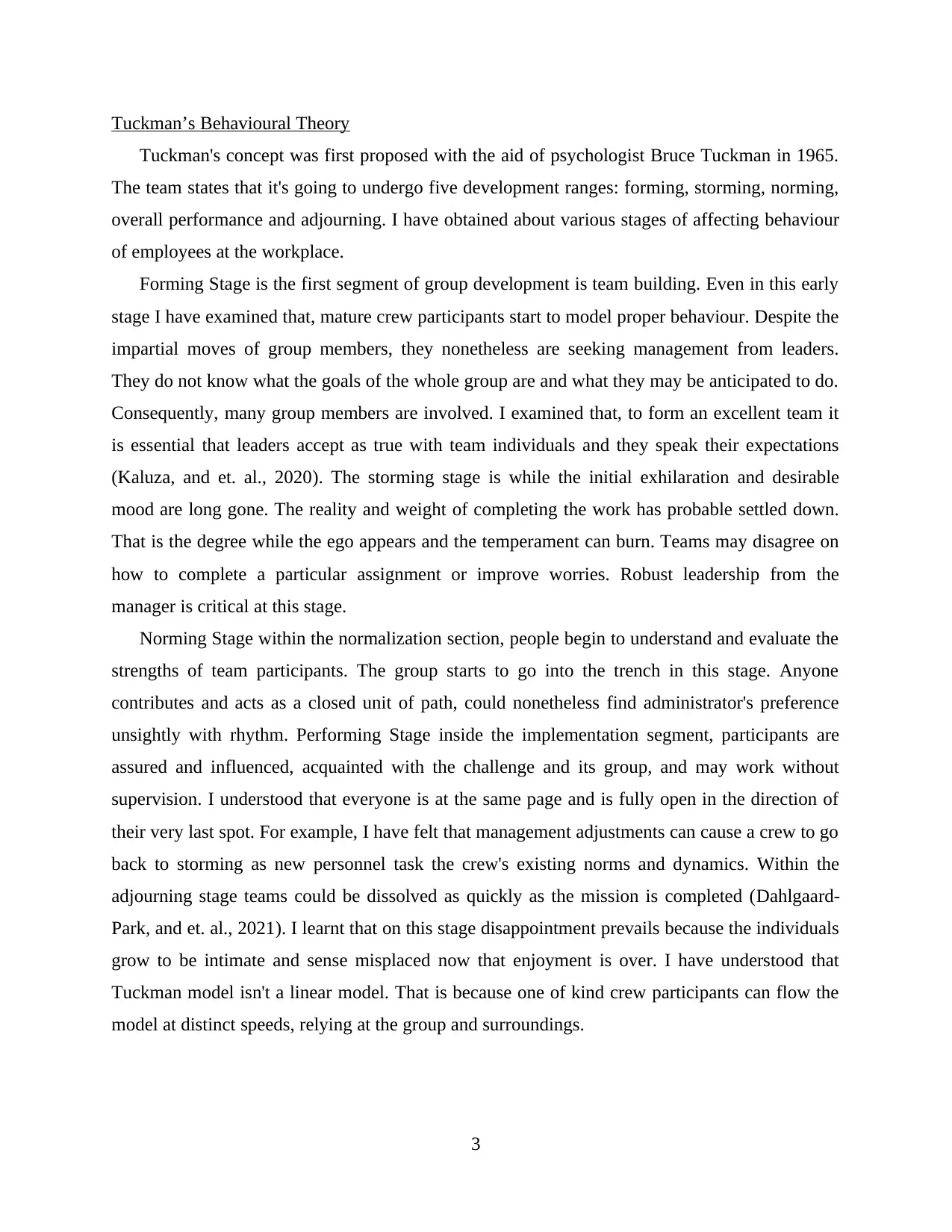
Tuckman’s Behavioural Theory
Tuckman's concept was first proposed with the aid of psychologist Bruce Tuckman in 1965.
The team states that it's going to undergo five development ranges: forming, storming, norming,
overall performance and adjourning. I have obtained about various stages of affecting behaviour
of employees at the workplace.
Forming Stage is the first segment of group development is team building. Even in this early
stage I have examined that, mature crew participants start to model proper behaviour. Despite the
impartial moves of group members, they nonetheless are seeking management from leaders.
They do not know what the goals of the whole group are and what they may be anticipated to do.
Consequently, many group members are involved. I examined that, to form an excellent team it
is essential that leaders accept as true with team individuals and they speak their expectations
(Kaluza, and et. al., 2020). The storming stage is while the initial exhilaration and desirable
mood are long gone. The reality and weight of completing the work has probable settled down.
That is the degree while the ego appears and the temperament can burn. Teams may disagree on
how to complete a particular assignment or improve worries. Robust leadership from the
manager is critical at this stage.
Norming Stage within the normalization section, people begin to understand and evaluate the
strengths of team participants. The group starts to go into the trench in this stage. Anyone
contributes and acts as a closed unit of path, could nonetheless find administrator's preference
unsightly with rhythm. Performing Stage inside the implementation segment, participants are
assured and influenced, acquainted with the challenge and its group, and may work without
supervision. I understood that everyone is at the same page and is fully open in the direction of
their very last spot. For example, I have felt that management adjustments can cause a crew to go
back to storming as new personnel task the crew's existing norms and dynamics. Within the
adjourning stage teams could be dissolved as quickly as the mission is completed (Dahlgaard-
Park, and et. al., 2021). I learnt that on this stage disappointment prevails because the individuals
grow to be intimate and sense misplaced now that enjoyment is over. I have understood that
Tuckman model isn't a linear model. That is because one of kind crew participants can flow the
model at distinct speeds, relying at the group and surroundings.
3
Tuckman's concept was first proposed with the aid of psychologist Bruce Tuckman in 1965.
The team states that it's going to undergo five development ranges: forming, storming, norming,
overall performance and adjourning. I have obtained about various stages of affecting behaviour
of employees at the workplace.
Forming Stage is the first segment of group development is team building. Even in this early
stage I have examined that, mature crew participants start to model proper behaviour. Despite the
impartial moves of group members, they nonetheless are seeking management from leaders.
They do not know what the goals of the whole group are and what they may be anticipated to do.
Consequently, many group members are involved. I examined that, to form an excellent team it
is essential that leaders accept as true with team individuals and they speak their expectations
(Kaluza, and et. al., 2020). The storming stage is while the initial exhilaration and desirable
mood are long gone. The reality and weight of completing the work has probable settled down.
That is the degree while the ego appears and the temperament can burn. Teams may disagree on
how to complete a particular assignment or improve worries. Robust leadership from the
manager is critical at this stage.
Norming Stage within the normalization section, people begin to understand and evaluate the
strengths of team participants. The group starts to go into the trench in this stage. Anyone
contributes and acts as a closed unit of path, could nonetheless find administrator's preference
unsightly with rhythm. Performing Stage inside the implementation segment, participants are
assured and influenced, acquainted with the challenge and its group, and may work without
supervision. I understood that everyone is at the same page and is fully open in the direction of
their very last spot. For example, I have felt that management adjustments can cause a crew to go
back to storming as new personnel task the crew's existing norms and dynamics. Within the
adjourning stage teams could be dissolved as quickly as the mission is completed (Dahlgaard-
Park, and et. al., 2021). I learnt that on this stage disappointment prevails because the individuals
grow to be intimate and sense misplaced now that enjoyment is over. I have understood that
Tuckman model isn't a linear model. That is because one of kind crew participants can flow the
model at distinct speeds, relying at the group and surroundings.
3
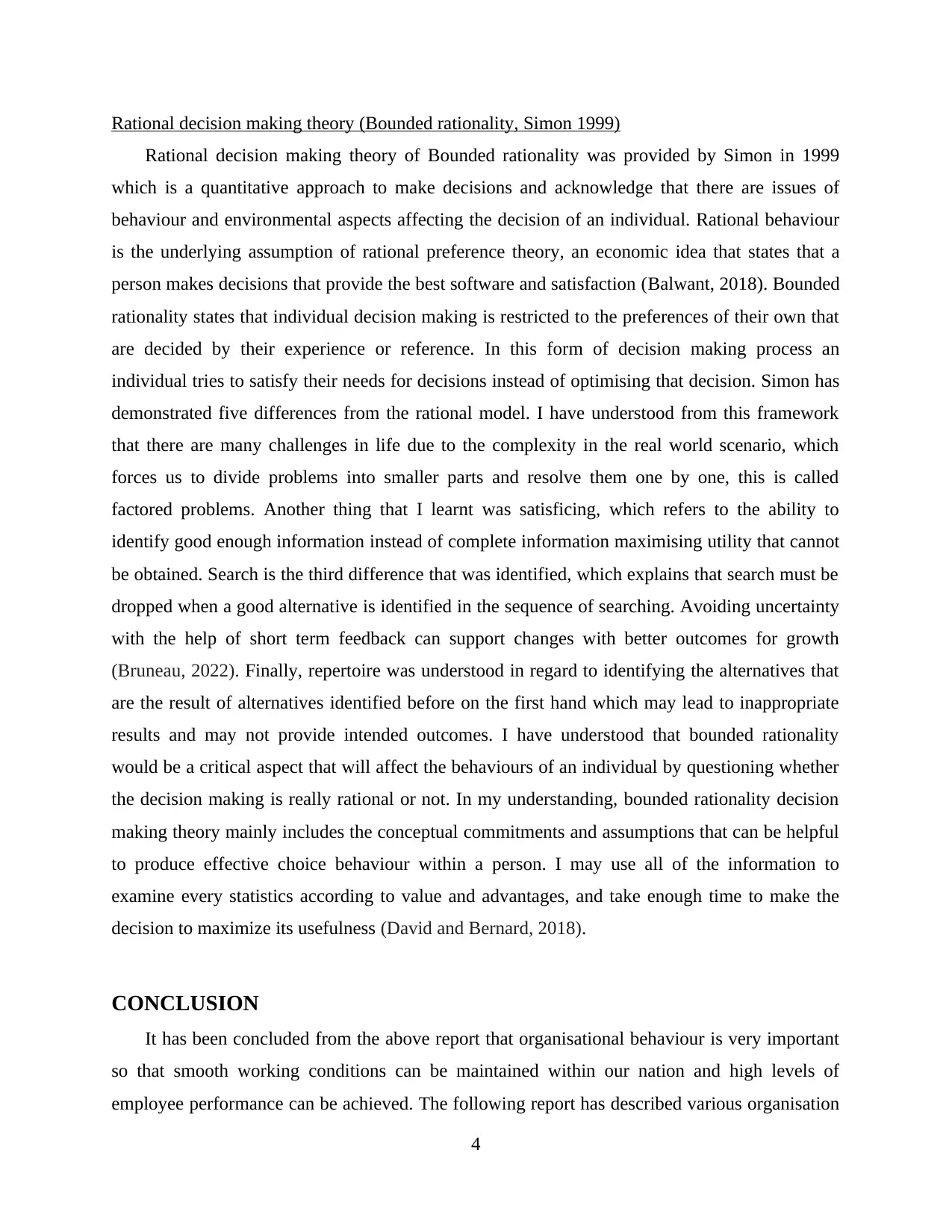
Rational decision making theory (Bounded rationality, Simon 1999)
Rational decision making theory of Bounded rationality was provided by Simon in 1999
which is a quantitative approach to make decisions and acknowledge that there are issues of
behaviour and environmental aspects affecting the decision of an individual. Rational behaviour
is the underlying assumption of rational preference theory, an economic idea that states that a
person makes decisions that provide the best software and satisfaction (Balwant, 2018). Bounded
rationality states that individual decision making is restricted to the preferences of their own that
are decided by their experience or reference. In this form of decision making process an
individual tries to satisfy their needs for decisions instead of optimising that decision. Simon has
demonstrated five differences from the rational model. I have understood from this framework
that there are many challenges in life due to the complexity in the real world scenario, which
forces us to divide problems into smaller parts and resolve them one by one, this is called
factored problems. Another thing that I learnt was satisficing, which refers to the ability to
identify good enough information instead of complete information maximising utility that cannot
be obtained. Search is the third difference that was identified, which explains that search must be
dropped when a good alternative is identified in the sequence of searching. Avoiding uncertainty
with the help of short term feedback can support changes with better outcomes for growth
(Bruneau, 2022). Finally, repertoire was understood in regard to identifying the alternatives that
are the result of alternatives identified before on the first hand which may lead to inappropriate
results and may not provide intended outcomes. I have understood that bounded rationality
would be a critical aspect that will affect the behaviours of an individual by questioning whether
the decision making is really rational or not. In my understanding, bounded rationality decision
making theory mainly includes the conceptual commitments and assumptions that can be helpful
to produce effective choice behaviour within a person. I may use all of the information to
examine every statistics according to value and advantages, and take enough time to make the
decision to maximize its usefulness (David and Bernard, 2018).
CONCLUSION
It has been concluded from the above report that organisational behaviour is very important
so that smooth working conditions can be maintained within our nation and high levels of
employee performance can be achieved. The following report has described various organisation
4
Rational decision making theory of Bounded rationality was provided by Simon in 1999
which is a quantitative approach to make decisions and acknowledge that there are issues of
behaviour and environmental aspects affecting the decision of an individual. Rational behaviour
is the underlying assumption of rational preference theory, an economic idea that states that a
person makes decisions that provide the best software and satisfaction (Balwant, 2018). Bounded
rationality states that individual decision making is restricted to the preferences of their own that
are decided by their experience or reference. In this form of decision making process an
individual tries to satisfy their needs for decisions instead of optimising that decision. Simon has
demonstrated five differences from the rational model. I have understood from this framework
that there are many challenges in life due to the complexity in the real world scenario, which
forces us to divide problems into smaller parts and resolve them one by one, this is called
factored problems. Another thing that I learnt was satisficing, which refers to the ability to
identify good enough information instead of complete information maximising utility that cannot
be obtained. Search is the third difference that was identified, which explains that search must be
dropped when a good alternative is identified in the sequence of searching. Avoiding uncertainty
with the help of short term feedback can support changes with better outcomes for growth
(Bruneau, 2022). Finally, repertoire was understood in regard to identifying the alternatives that
are the result of alternatives identified before on the first hand which may lead to inappropriate
results and may not provide intended outcomes. I have understood that bounded rationality
would be a critical aspect that will affect the behaviours of an individual by questioning whether
the decision making is really rational or not. In my understanding, bounded rationality decision
making theory mainly includes the conceptual commitments and assumptions that can be helpful
to produce effective choice behaviour within a person. I may use all of the information to
examine every statistics according to value and advantages, and take enough time to make the
decision to maximize its usefulness (David and Bernard, 2018).
CONCLUSION
It has been concluded from the above report that organisational behaviour is very important
so that smooth working conditions can be maintained within our nation and high levels of
employee performance can be achieved. The following report has described various organisation
4
⊘ This is a preview!⊘
Do you want full access?
Subscribe today to unlock all pages.

Trusted by 1+ million students worldwide
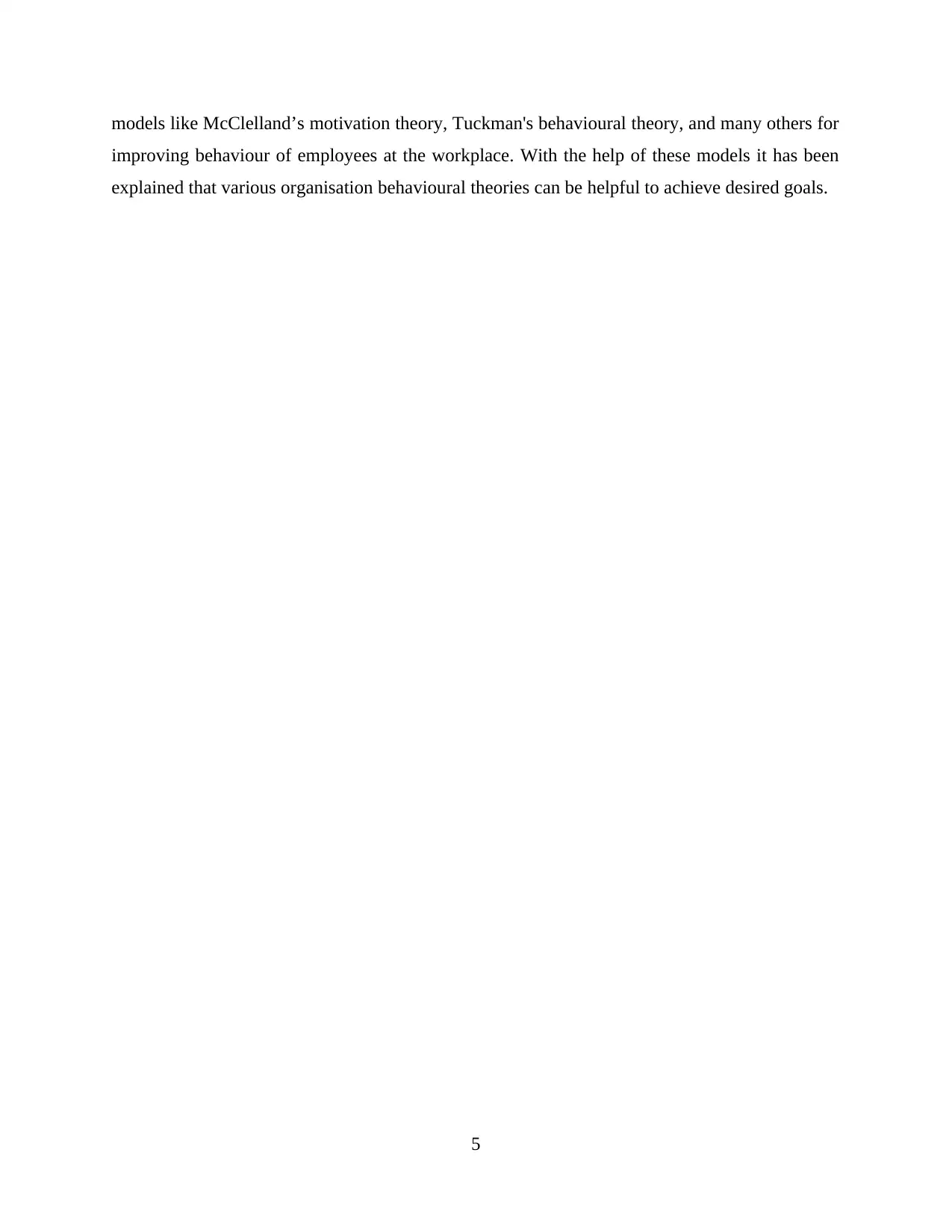
models like McClelland’s motivation theory, Tuckman's behavioural theory, and many others for
improving behaviour of employees at the workplace. With the help of these models it has been
explained that various organisation behavioural theories can be helpful to achieve desired goals.
5
improving behaviour of employees at the workplace. With the help of these models it has been
explained that various organisation behavioural theories can be helpful to achieve desired goals.
5
Paraphrase This Document
Need a fresh take? Get an instant paraphrase of this document with our AI Paraphraser
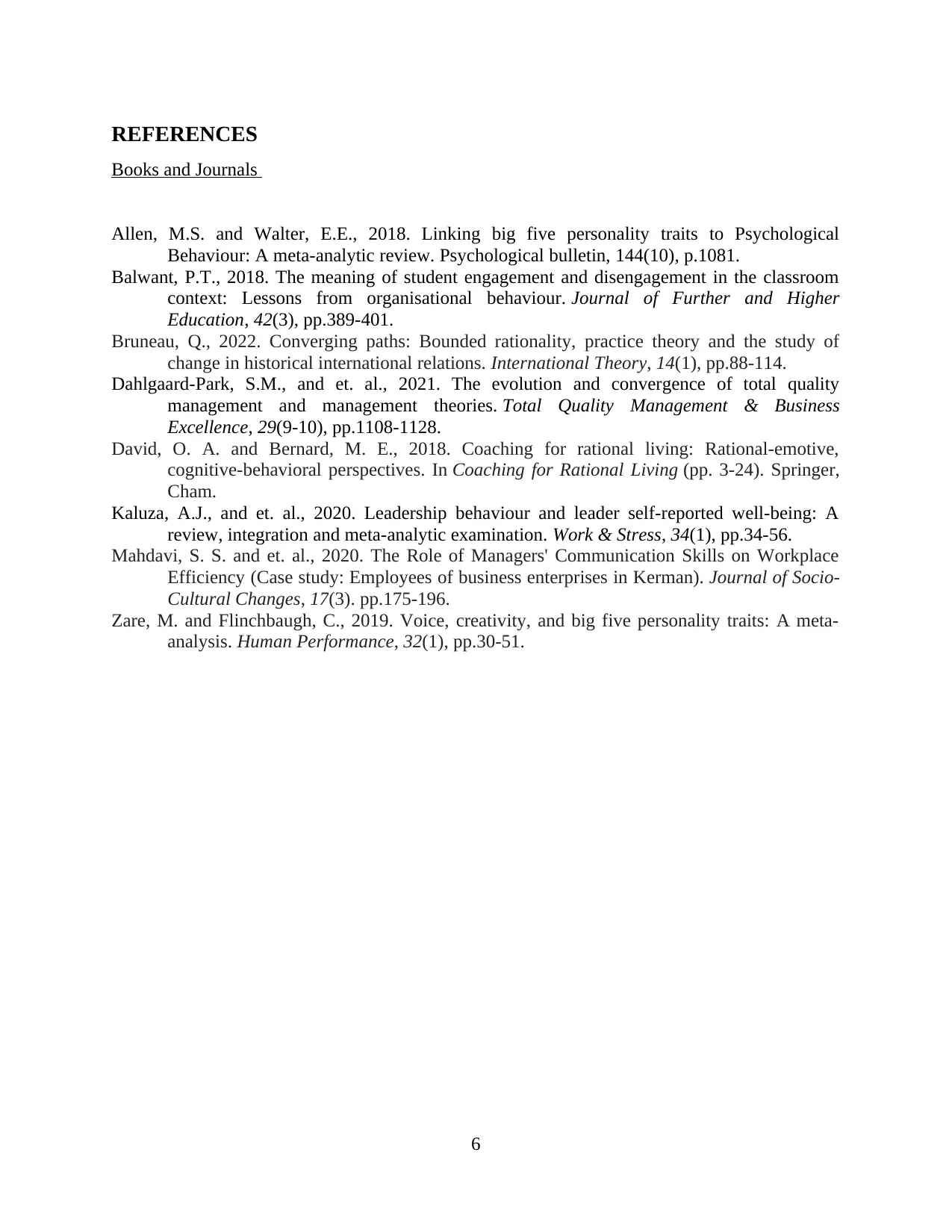
REFERENCES
Books and Journals
Allen, M.S. and Walter, E.E., 2018. Linking big five personality traits to Psychological
Behaviour: A meta-analytic review. Psychological bulletin, 144(10), p.1081.
Balwant, P.T., 2018. The meaning of student engagement and disengagement in the classroom
context: Lessons from organisational behaviour. Journal of Further and Higher
Education, 42(3), pp.389-401.
Bruneau, Q., 2022. Converging paths: Bounded rationality, practice theory and the study of
change in historical international relations. International Theory, 14(1), pp.88-114.
Dahlgaard-Park, S.M., and et. al., 2021. The evolution and convergence of total quality
management and management theories. Total Quality Management & Business
Excellence, 29(9-10), pp.1108-1128.
David, O. A. and Bernard, M. E., 2018. Coaching for rational living: Rational-emotive,
cognitive-behavioral perspectives. In Coaching for Rational Living (pp. 3-24). Springer,
Cham.
Kaluza, A.J., and et. al., 2020. Leadership behaviour and leader self-reported well-being: A
review, integration and meta-analytic examination. Work & Stress, 34(1), pp.34-56.
Mahdavi, S. S. and et. al., 2020. The Role of Managers' Communication Skills on Workplace
Efficiency (Case study: Employees of business enterprises in Kerman). Journal of Socio-
Cultural Changes, 17(3). pp.175-196.
Zare, M. and Flinchbaugh, C., 2019. Voice, creativity, and big five personality traits: A meta-
analysis. Human Performance, 32(1), pp.30-51.
6
Books and Journals
Allen, M.S. and Walter, E.E., 2018. Linking big five personality traits to Psychological
Behaviour: A meta-analytic review. Psychological bulletin, 144(10), p.1081.
Balwant, P.T., 2018. The meaning of student engagement and disengagement in the classroom
context: Lessons from organisational behaviour. Journal of Further and Higher
Education, 42(3), pp.389-401.
Bruneau, Q., 2022. Converging paths: Bounded rationality, practice theory and the study of
change in historical international relations. International Theory, 14(1), pp.88-114.
Dahlgaard-Park, S.M., and et. al., 2021. The evolution and convergence of total quality
management and management theories. Total Quality Management & Business
Excellence, 29(9-10), pp.1108-1128.
David, O. A. and Bernard, M. E., 2018. Coaching for rational living: Rational-emotive,
cognitive-behavioral perspectives. In Coaching for Rational Living (pp. 3-24). Springer,
Cham.
Kaluza, A.J., and et. al., 2020. Leadership behaviour and leader self-reported well-being: A
review, integration and meta-analytic examination. Work & Stress, 34(1), pp.34-56.
Mahdavi, S. S. and et. al., 2020. The Role of Managers' Communication Skills on Workplace
Efficiency (Case study: Employees of business enterprises in Kerman). Journal of Socio-
Cultural Changes, 17(3). pp.175-196.
Zare, M. and Flinchbaugh, C., 2019. Voice, creativity, and big five personality traits: A meta-
analysis. Human Performance, 32(1), pp.30-51.
6
1 out of 8
Related Documents
Your All-in-One AI-Powered Toolkit for Academic Success.
+13062052269
info@desklib.com
Available 24*7 on WhatsApp / Email
![[object Object]](/_next/static/media/star-bottom.7253800d.svg)
Unlock your academic potential
Copyright © 2020–2025 A2Z Services. All Rights Reserved. Developed and managed by ZUCOL.





